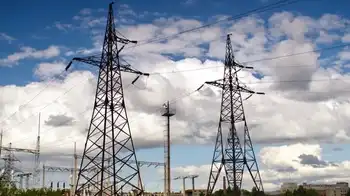Power line may trigger surge in rates
By Knight Ridder Tribune
Substation Relay Protection Training
Our customized live online or in‑person group training can be delivered to your staff at your location.

- Live Online
- 12 hours Instructor-led
- Group Training Available
Other new lines, from West Virginia and western Pennsylvania, could pull the price back down - although that outcome is far from certain. "Power costs tend to increase as you move east," Robert McCullough, a Portland, Ore.-based energy consultant, explained. "You would expect that the less expensive power supplies from Pennsylvania will flow to New Jersey."
The Pennsylvania-New Jersey line will start at PPL Corp.'s Susquehanna nuclear power plant, about 75 miles northwest of the Lehigh Valley in Salem Township, Luzerne County, and end at the Roseland substation near Newark, N.J. PPL, of Allentown - the company responsible for the Pennsylvania portion of the 130-mile, 500 kilovolt line - expects the project to be completed by 2012.
Any impact on prices at that time could be an especially sensitive matter because much of eastern Pennsylvania is likely to have recently experienced its biggest-ever electricity rate hike. Rates within PPL's service territory, for example, are expected to surge 35 percent for residents and up to 42 percent for some businesses in 2010.
That's when, in the final step of electricity deregulation, a cap on what PPL can charge is due to expire Caps for other major eastern Pennsylvania electricity providers, including Metropolitan Edison Co. and PECO, are to end the following year. PJM Interconnection of Valley Forge, the electric industry-owned organization that manages the regional power grid, authorized construction of the Pennsylvania-New Jersey line in June.
PJM officials said the decision, made with input from PPL, was based solely on the need to upgrade a multi-state network of wires that could soon be overloaded. Not only is energy consumption on the rise, but so is long-distance electricity transmission. As result of deregulation, utilities that once mostly tapped their own local power plants, now buy more electricity from far-away sources - a transaction that requires transmission over high-tension power lines.
"It's being built for reliability, not economic needs," PJM spokeswoman Paula DuPont-Kidd said, explaining why PJM did not consider the impact the new line could have on the price of electricity.
Such impact, independent electricity experts say, will come from a shift in supply and demand.
Because Pennsylvania has more excess electricity than New Jersey, the price of electricity in Pennsylvania is cheaper than in New Jersey. In fact, at an average price of more than 15 cents per kilowatt hour, New Jersey has the second-most expensive electricity in the continental United States, according to the most recent government data; by comparison, Pennsylvania's average price is about 91/2 cents.
But a new high-tension power line will allow Pennsylvania's excess electricity to cross the state line, into markets it could not previously reach.
As result, New Jersey will be able to compete with Pennsylvania for electricity Pennsylvanians once ha to themselves. "It has to do with relative prices," said Marilyn Showalter, who heads Power in the Public Interest, a group opposed to electricity deregulation.
"Exporting to a higher-priced market will drive up prices (in the lower-priced market)."
Of course, it will also drive down prices in the higher-priced market - that is, New Jersey. PPL also will benefit because it will enjoy better access to a market where its product can fetch a higher price. In the end, Pennsylvania and New Jersey prices will gravitate toward each other, according to Ken Rose, a senior fellow at the Institute of Public Utilities at Michigan State University. He said they will stabilize "somewhere in the middle."
Although PJM did not consider the Pennsylvania-New Jersey line's potential impact on prices before authorizing construction, it has put some effort into studying the matter. PJM projected the line would result in less than a 1 percent price increase in Pennsylvania, but the increase would be more than offset by other new lines carrying to eastern Pennsylvania relatively cheap electricity generated at coal-fired power plants such as in West Virginia.
PJM officials, though, cautioned against placing too much faith in those findings because they were not intended to be the final word on future prices, and the models on which they were based relied heavily on assumptions.
Indeed, Pennsylvania consumer advocate Sonny Popowsky identified one variable that could alter all the equations: global warming legislation. He noted that a carbon tax, which some industry observers expect the federal government to impose in the not-to distant future, would raise the price of coal-based electricity.
If such a tax is imposed, West Virginia would not help offset New Jersey's influence on Pennsylvania electricity prices. "There is that additional wrinkle," Popowsky said. PPL, meanwhile, has sent engineers into the field to sight a path for the 100-mile-long, 200-foot-wide swath the new line will cut through Pennsylvania.
Public Service Electric and Gas Co. of Newark and FirstEnergy Corp. of Akron, Ohio, are responsible or the New Jersey side. It's work that is likely to set off a political firestorm - building the 150-foot steel towers, widely regarded as eyesores, often require condemnation of private property through eminent domain.
Already, Pennsylvania officials are wrangling with the federal government over who will have final say over the matter. But like PJM, PPL describes the project as one of necessity.
"It's not out of the line to say that there could be blackouts if that system isn't shored up," PPL Spokesman Paul Wirth said.
"The bottom line is, if demand for electricity is growing - and it is - new power lines will be needed."











